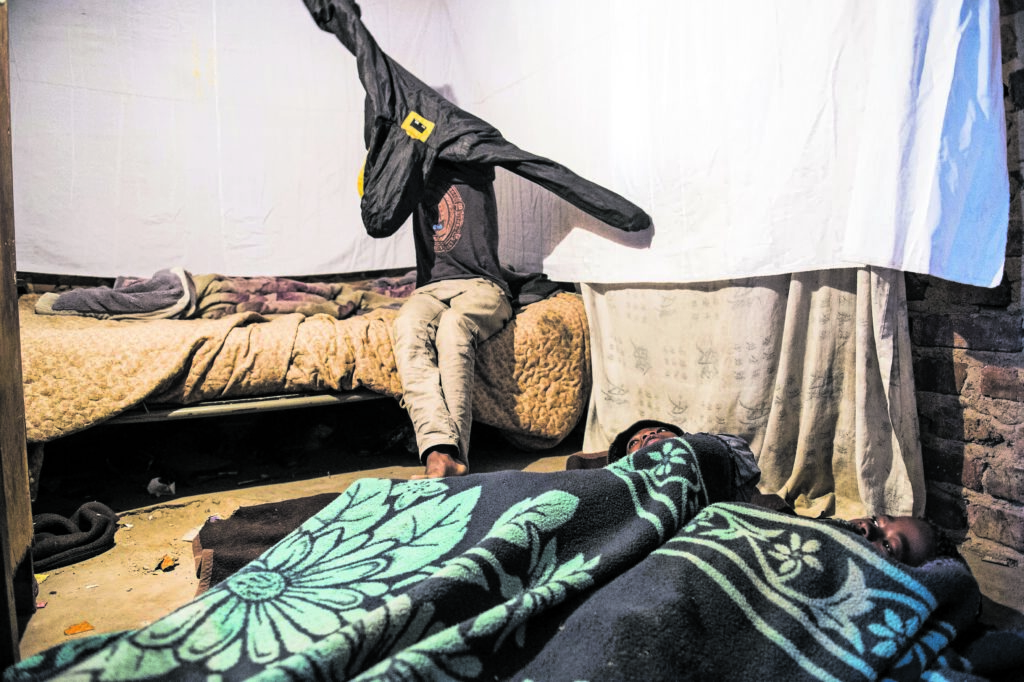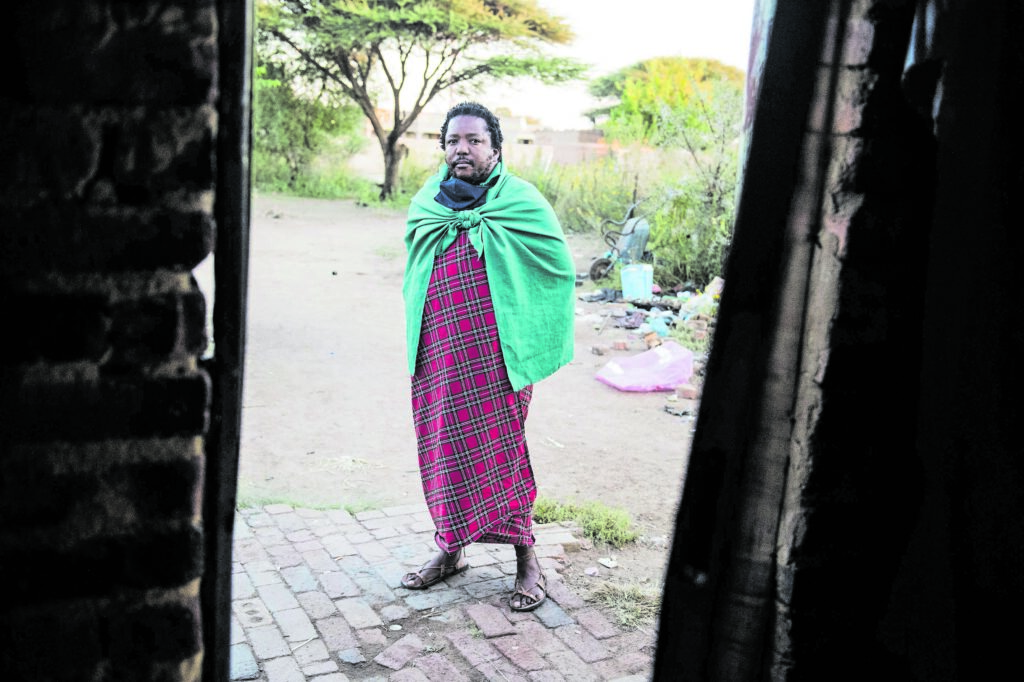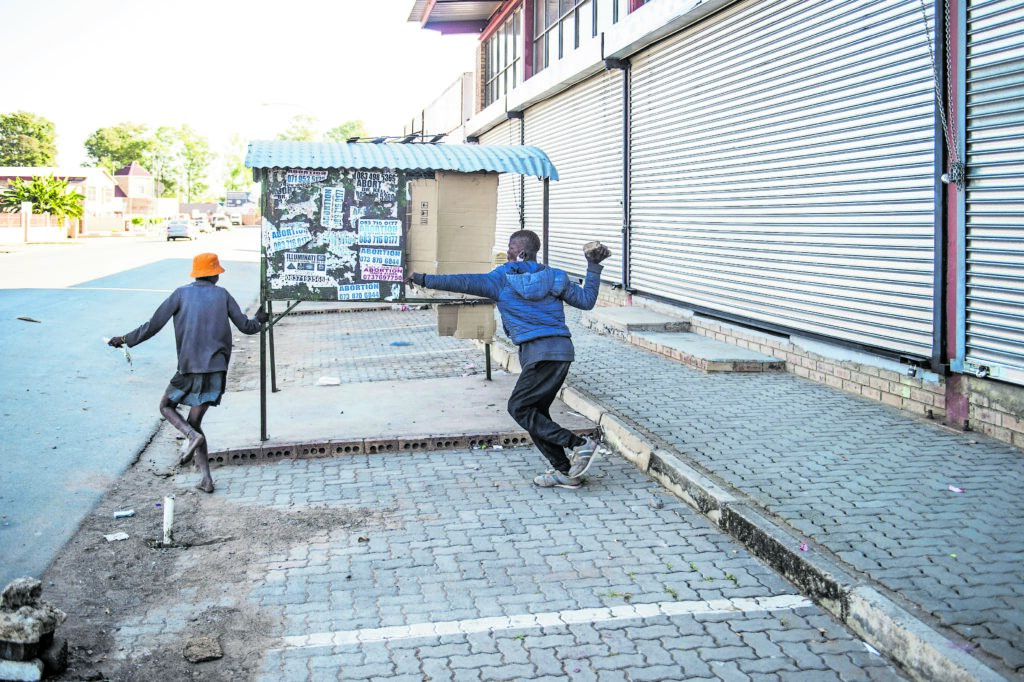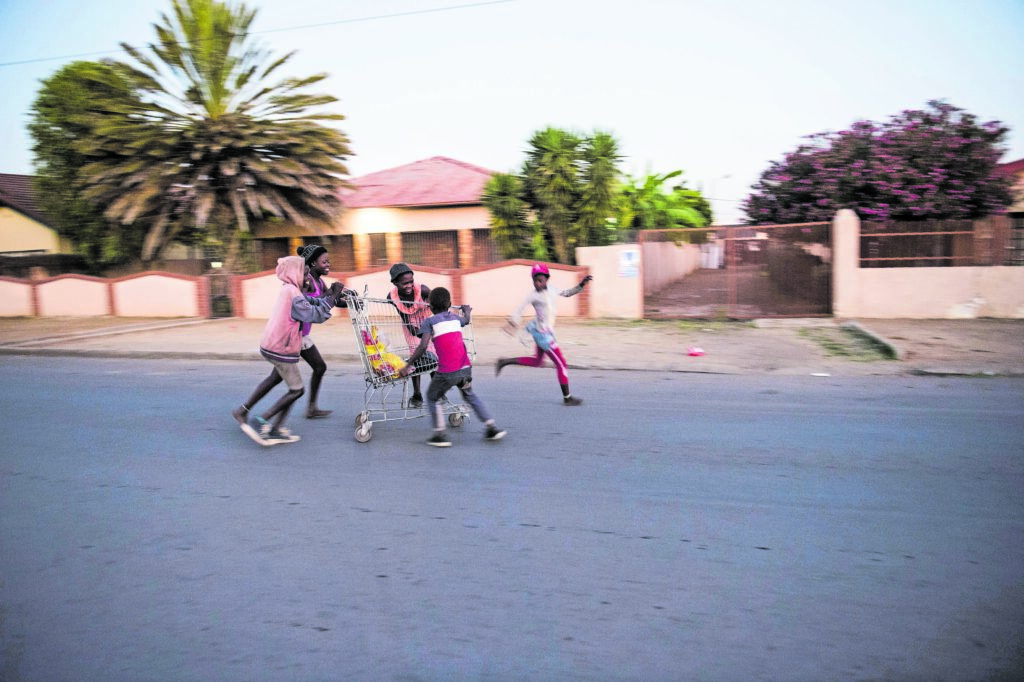Street life: Racing with a shopping trolley provides an all-too-rare moment of fun for the at-risk children of Mahikeng. Photos: Delwyn Verasamy
A R55-million centre built in Mahikeng, North West, for at-risk children and orphans referred by the courts sits unused to this day following its temporary closure in 2019.
Commissioned in 2011, the Boikagong Child and Youth Care Centre has been closed since 25 July 2019 because of registration “challenges” that at the time were described as “infrastructural defaults and issuing out of compliance certificates”.
Back in 2019, the North West’s social development MEC, Boitumelo Moiloa, promised that all the children would be rehoused while the renovations and registration were finalised.
But today, more than 20 children who once lived at the home are on the streets, taking part in the very things they were supposed to be protected from — snorting and inhaling drugs and selling their young bodies for food and shelter.
The Mail & Guardian spent three days with the children as they roamed the streets of Mahikeng.
The Boikagong centre was opened amid much fanfare in January 2011 by then-premier and now National Assembly speaker Thandi Modise, but the grand vision for the facility has collapsed due to ineptitude.
Today, the victims of this ineptitude include a 12-year-old girl who speaks as nonchalantly of being raped and sexually assaulted by adult men as if she were sharing tales of buying a loaf of bread from the corner shop.

Violence is now a permanent feature of these children’s lives, they say. Some of their bodies are scarred from stab wounds — a reminder of their place in a world that was not kind to them to start with.
A social worker who once worked at the centre has told the M&G about the “pain” of seeing the number of street children in the area swell since Boikagong’s closure. “It didn’t have to be this way,” said the social worker. But government incompetence had taken a firm hold.
The children want education
None of the children the M&G spent time with is at school, but the eagerness to learn is etched on their faces. All of the children excitedly assert that, given the opportunity, they would want to go back to school.
They become visibly nostalgic as they recall their time at Boikagong: waking up to hearty meals in the brightly coloured dining hall with their peers and heading to artistically decorated classrooms for lessons.
 White elephant: Bureaucratic failings and politicians’ broken promises mean that the safest home the children ever knew (above and right) has stood empty since July 2019. The children were never rehoused as promised
White elephant: Bureaucratic failings and politicians’ broken promises mean that the safest home the children ever knew (above and right) has stood empty since July 2019. The children were never rehoused as promised
But instead, one boy, who is deaf, and whose friends said was crafty with his hands while at the centre, is now using his skills to create the best joints and glue cartons. He and his friends regularly brawl over his creations.
The hearty morning meals have also gone, so the former residents instead sniff glue on street corners from as early as 6am.
Bonolo*, a vibrant 12-year-old girl, casts her eyes down in shame as she tells the M&G she probably would not be having sex with adult men if she still lived at the centre.
“Yes, men come to me all the time to offer me money provided that I go home with them and have sex. The taxi drivers, especially, will buy me new clothes and demand that I bath before sleeping with them,” she said.
“People keep telling me that what they are doing to me is rape, but I don’t see it that way. At least I get to eat and be clean for a few days before the men get tired of me and choose another girl.”
The petite child is wearing tattered, dirty clothing when we speak to her, her mouth ashen from the glue-sniffing. She constantly scratches at herself with long, darkened nails, as if to quell a constant itch.
Bonolo says she stopped going to school in Grade 3, shortly after Boikagong closed its doors, but would return in a heartbeat if given a chance.
“I want to return to school, but it needs to be at a place of safety because I cannot live with my family,” she says. “I hope to become a police officer one day to protect children who come from tough backgrounds such as me.”
A 16-year-old boy interjects: he wants to be a lawyer so that he can one day speak on behalf of children when they get into trouble.
His enthusiasm is a brief jolt of energy from the otherwise slow nature of his speech — the result of the nyaope joint he has just smoked.
“We sometimes get taken by the police when they find us with drugs or when we fight rival groups in the street,” the boy says.
“I understand that the police are just doing their jobs, but I sometimes wish that we had lawyers who would be on our side when we are taken into custody. That is why I want to be a lawyer.”
Boikagong then and now
When the M&G visited the deserted centre, dry weeds and other vegetation had engulfed Boikagong.
When the provincial government enthused about its opening, it said the centre would “provide shelter to orphans, children suffering from abuse and children from dysfunctional families”.
“With this centre, the North West department of social development, women, children and people with disabilities will create a conducive environment for fostered children to [grow up in],” the provincial government had said.
But today, the more than a dozen buildings and houses that once formed part of the Boikagong Centre on its huge plot of land is nothing but an ode to bureaucratic incompetence, negligence and apathy: broken windows, crumbling fences and rusted corrugated iron roofing.
There are no signs of security guarding the centre, with community members in the area saying that criminals often stripped parts from the buildings to sell at scrap yards.

Neighbours tell the M&G that the only signs of life at Boikagong are the stream of luxury vehicles that occasionally visit the facility, for reasons unknown.
“This place used to be buzzing with children, who received much-needed care away from the painful situations they were rescued from,” said a neighbour, who asked to remain anonymous.
“Now we have to wake up and look at this discarded eyesore that is not maintained and attracts unsavoury people, who seek to loot from it.
“I don’t blame the people who are stripping the facility. At least they are putting it to some use, unlike our government, which spent millions of rands on the centre only to chuck it away like we do our garbage.”
The centre was beset with problems before it closed, including a fire in March 2015 that severely damaged three blocks. Fortunately, none of the 74 children who were housed at Boikagong at the time was injured in the blaze.
One of the older children the M&G spoke to remembers the fire.
“We woke up in the middle of the night and the centre had to be temporarily closed after the fire. None of us were harmed because it happened in the buildings that were not occupied by anyone at the time,” said the boy.

“But it was very scary to many of us that a fire could start at the centre and no one would know how or why it happened,” he said.
He said he had stopped going to school two years ago, in Grade 4, when he was 15 years old.
He is quick to add that his peers were now in Grade 7, perhaps to reassure himself — and us — that he was not too far behind and could still catch up should he get the chance to do so.
A former caregiver at Boikagong said even though the children were referred to the centre because of the difficult homes they came from, most of them retained their innocence.
“It is still a mystery how the centre remained open when the [social development department] knew it was not compliant, even after the [2015] fire. But I do miss the children’s laughter. That was the best thing about working at Boikagong,” the worker told the M&G.
Protection cliques
Today, groups of children band together in cliques as a form of protection.
One group has a 21-year-old man who acts as a protector to the young children on the streets, shielding them from their rivals. The 21-year-old said he had to protect the children because it got “really rough”, especially when, as he claims, taxi drivers prey on the girls for sex. The young man, who stayed at Boikagong before leaving two years before the centre’s closure, showed the M&G scars from stabbings on the back of his head and just under his armpit, near his heart.

He says the wounds were inflicted by rival street groups with whom his group competed with for territory: the best places to hustle for food and money for mind-altering substances.
“It really gets tough on the streets, we hurt each other a lot and I think it is a miracle that I am still alive. Given the opportunity, I would love to go to a trade college because I really am good with my hands,” he says.
“None of us would be living this violent lifestyle had the doors of Boikagong and other youth centres not closed for us.”
Fights regularly erupt as the children jostle for nyaope joints and glue, the leader says.
On one of the days that the M&G spends with the children, the deaf boy, carrying a brick, chases another boy during a fight over a milk carton.

The deaf boy’s rage is clear as he lets out a muffled, anguished sound.
“The deaf boy is always angry,” says the group leader.
“Some of the children always tease him and that brings out his anger. But I know that we all care about him and have to protect him like he protects some of the younger girls from the predators.”
Detailed questions were sent to the North West department of social development’s spokesperson, Petrus Siko.
He had not answered any questions at the time of publication despite repeatedly saying that he would respond, and the M&G granting him more than a week to do so.
Nights on the street
When night falls, the children gather at the local mosque, taxi rank or food outlets as a final hustle to buy something to eat, as well as to score their glue and nyaope for the night.
This seems to be the busiest time of the day for the children, who break from their groups and fend for themselves in a mad dash to obtain the night’s supplies.
And despite their grim day-to-day realities, despite their squalid surroundings, sometimes, the children’s playfulness shines through. A retail trolley usually used to transport groceries for cash is converted into a makeshift go-kart and “driven” through the town’s pothole-riddled streets.

On Freedom Day — with fewer people in town — the trolley provides great entertainment when there are no goods to carry for shoppers.
The quiet, empty streets are suddenly flooded with screaming, laughing children, their joy-filled voices reverberating across the small town, providing a moment’s respite from a difficult existence.
One of the groups of children has commandeered sleeping quarters in a village about 7km outside of the main town centre.
The “quarters” are a four-by-two-metre shack that greets one with a stomach-churning stink upon arrival, the lack of ventilation making the room a suffocating experience.
When it is time to head back to the villages for the night, the older children, usually boys and young men, walk around town looking for scattered members of their groups so they can all walk together.
On the night of Freedom Day, the walk home becomes chaotic. Some of the younger girls want to stay on the streets longer in a last-gasp attempt to score a few coins.

And unless somebody does something, unless there is targeted and sustainable intervention, the trek to their stuffy shack through the dark will be followed the next day, and the next, and the next, by the same routine — an early morning rise for a quick fix from laced milk cartons, and a day spent trying to forget that you are a child.
*Names have been changed